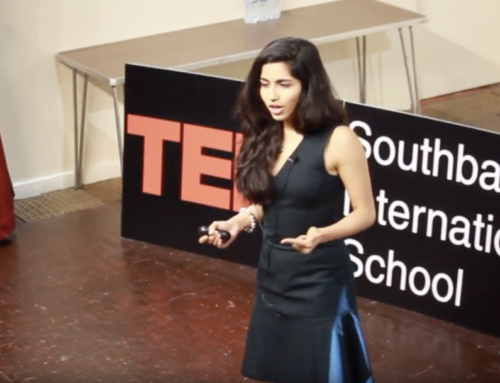I’ve blogged about Malcolm Gladwell before, and given him mixed reviews as a good storyteller, but a speaker with some quirks that got in the way of maximum effectiveness.
Well, it’s time to give Gladwell a second look. His TED talk from July 2011, posted in October, is a masterpiece of the storytelling art, and it is delivered well. This is a talk that any speaker can learn from. If you’re a polished performer, learn from Gladwell’s pacing and tonal variety – and his storytelling. If you’re a novice, then focus on Gladwell’s storytelling, because it is so good that it makes me wish that more speakers would up the ante on themselves and weave a tale as well as he does.
OK, what is it that Gladwell does so brilliantly? Five lessons of the storyteller’s art come from this TED video and the “Strange Tale of the Norden Bombsight.”
First, Gladwell grabs our interest with the high stakes of the story. The best stories are matters of life and death. Of course, a story about a bombsight is exactly that. Our interest is piqued because we’re talking about war, death, and destruction. It’s the storyteller’s equivalent of shouting “fire!” in a crowded theatre – it gets our attention.
Second, Gladwell structures the story in three parts or acts, with the right kind of conclusion. In the first part, or act, Gladwell tells us about Norden and his bombsight and what it was supposed to do. In this way he builds up the interest in the device. Instead of telling us the story retrospectively, he puts us in the time period, in the search for an accurate way to aim bombs, and he tells us why that’s important.
In the second part, Gladwell tells us what actually happened with the Norden bombsight, and why it didn’t deliver on its promise for pinpoint accuracy. This unexpected turn keeps our interest in the story high, because he’s made us care about the device and we want to know why it fails.
And in the third part of his tale, Gladwell draws the larger moral of the story. The point of his tale, again surprising, is that the search for pinpoint accuracy is not the right quest. Instead, we need to be thinking about things like the bombsight in a different and more profound way, with their inherent limitations. The complexity of human issues, we learn, defies solution by the simplicity of things.
And stay tuned for the postscript with which Gladwell closes his tale. It’s brilliant.
Third, Gladwell peppers his story with precise, relevant details – but not too many. Details bring stories to life. And they kill stories when there are too many of them. Gladwell knows exactly when to give us a telling detail, and when to ease up and keep us at the 20,000-foot view. We know exactly how many SCUD missile launchers the US successfully took out during the Iraq war — zero – but we never get a precise description of the bombsight itself. Why? Because only an engineer would care. The bombsight is too complicated. The average listener only care about its effects.
Fourth, Gladwell has (mostly) conquered his ‘happy feet’ problem. In his earlier talks, Malcolm’s nervous energy showed up in relentless pacing up and down the stage. Now, he’s relaxed enough (or practiced enough) to come to a halt and plant his feet occasionally, and that simple shift makes an enormous difference in his effectiveness. A storyteller's job is to stand and deliver, so that motion doesn't get in the way of comprehension, but rather reinforces it.
Fifth, Gladwell varies his pacing and pitch with the ebb and flow of the story. Advanced speakers should watch and listen to the video focusing on Gladwell’s voice. It’s resonant and strong, and he varies it expertly, speeding up and raising the volume at times, and slowing down and lowering both pitch and volume when he needs a dramatic emphasis. This TED talk shows Gladwell at the peak of his game. Now, if we can just get him to tuck in his shirt….








Thank you, Nick. I’m enjoying this series of yours too.
A quick note on Gladwell — he is a brilliant story teller but I’ve always felt he is so much better at it as a writer than as a speaker.
When he writes, he connects. When he speaks (these days at least) there seems very, very little connection between him and his audience (take a look at ALL of the audience cut-away shots in the ‘Nordern’ piece to see what I mean).
Not only that, you’re right that these days he uses his voice better. But many times (it seems to me) he ups the volume inappropriately so that it becomes weird and forced.
I think the connection piece could be ‘solved’ if the framing were done better. Essentially he just jumps into it, after referencing his famous Spaghetti piece, without letting us really know the journey he’s about to take us on.
So most of the time the audience is looking perplexed — as in ‘where the heck is this going?’
And yes, his P.S. is good but it is so underplayed. And when he delivers it, he really doesn’t know where to go — hence that impish bow at the end. And really tempered applause follows.
That said, Nick, he is a brilliant story teller and we can learn from him (and you!)
Today, be sure to keep on doing …..
….. things that amaze you.
Paul
Hi, Paul–
Good to hear from you.
Thanks for your comment on Gladwell. He always generates controversy! Beware of reading too much into the cutaway shots. Those are often done randomly and may or may not even be of his talk.
I agree that he is a better writer than a speaker, but I do think his speaking has improved considerably.